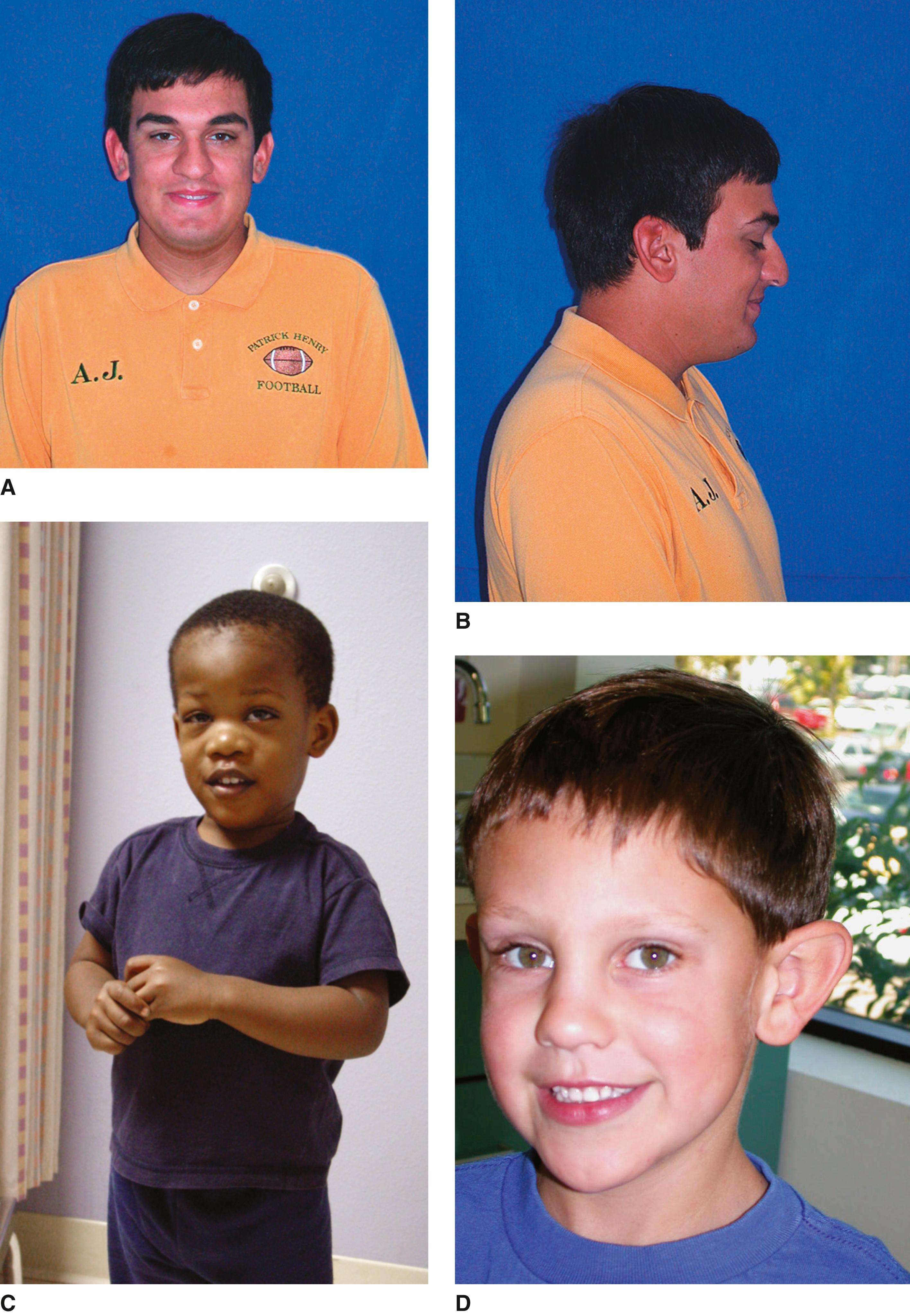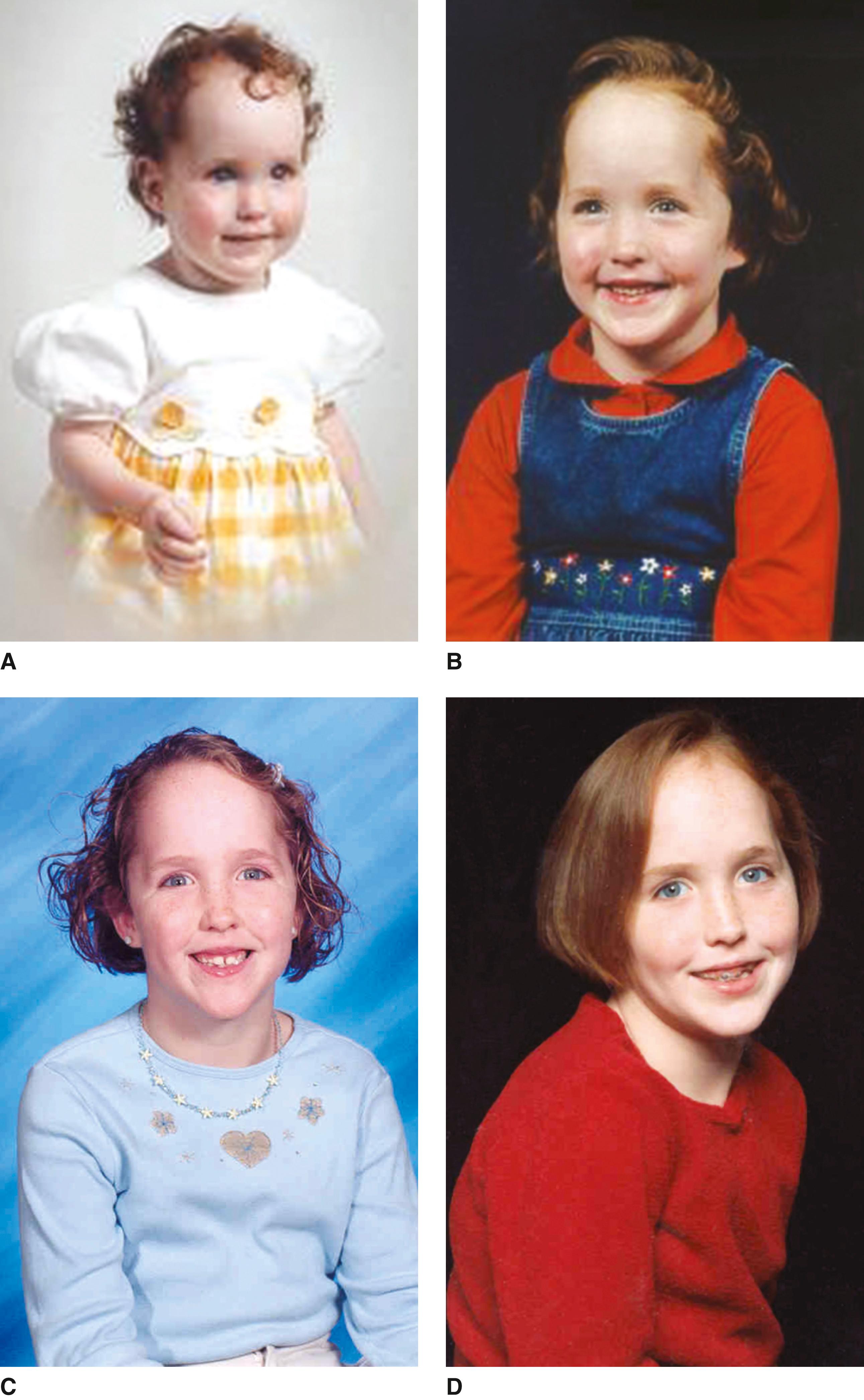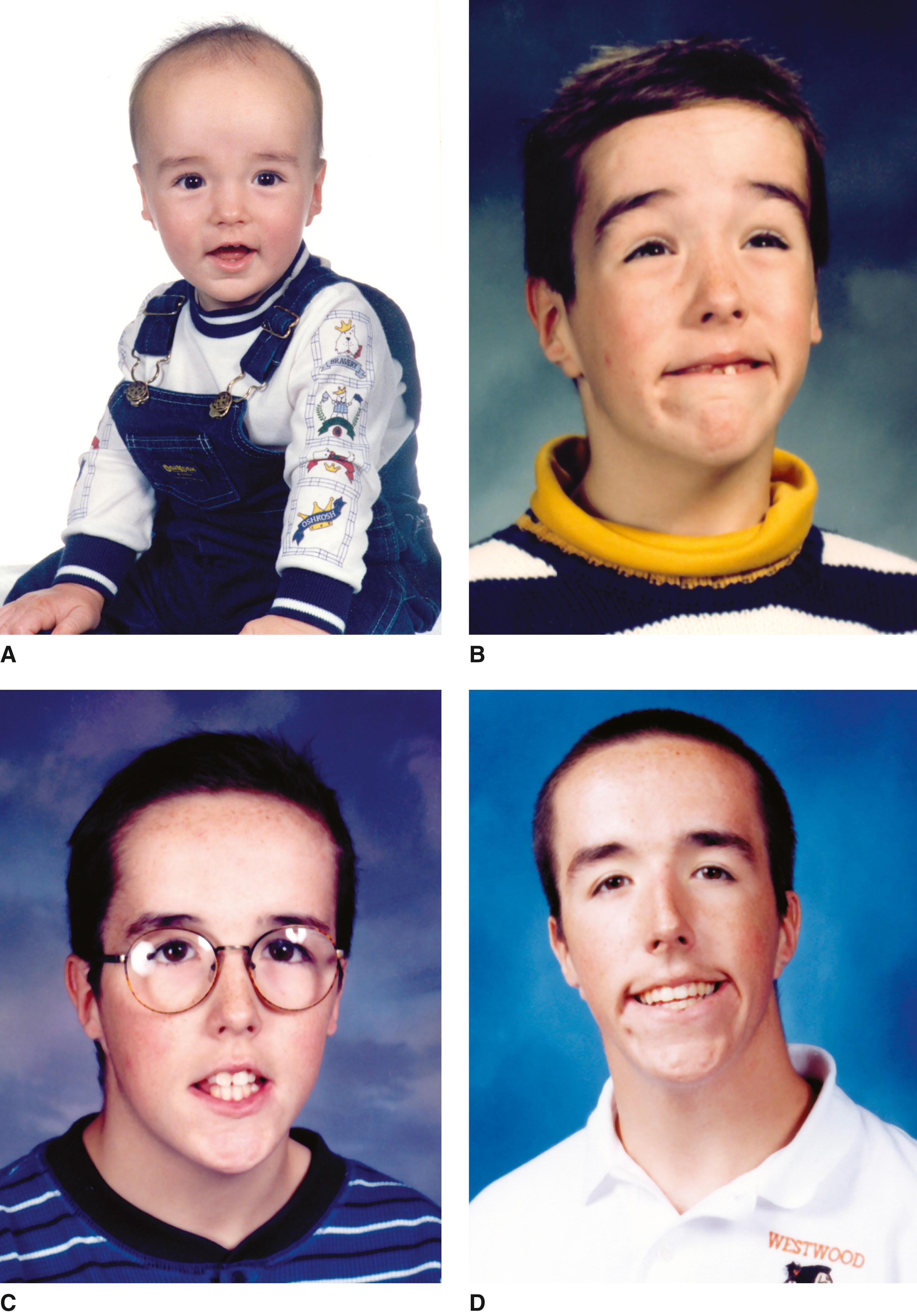Physical Address
304 North Cardinal St.
Dorchester Center, MA 02124
In 1943, Martin and Bell published the first pedigree documenting an X-linked form of intellectual disability. Lubs, in 1969, showed the presence of a fragile site on the long arm of the X chromosome in affected males and some carrier females in one family. Macroorchidism without endocrinologic abnormalities was described by Turner and colleagues and Cantu and colleagues in the affected males of a number of families. Fragile X syndrome (FXS) is the most common form of monogenic hereditary cognitive impairment.
An incidence of 1 in 5000 males has been calculated from analysis of newborn blood spots. Among individuals with developmental delay, intellectual disability, and/or autism, between 1% and 3% will have a full mutation. The phenotype is identified most and with greater severity in males.
Growth. Macrocephaly (HC) above the 50th centile in early childhood; accelerated linear growth in childhood; however, growth velocity slows at adolescence. Obesity with a subset having a Prader-Willi phenotype (hyperphagia and hypogonadism).
Performance. Generally moderate to profound intellectual disability (ID) in males with intelligence quotients (IQs) of 30 to 55, but sometimes extending into the mild ID to borderline normal range. Hand flapping or biting (60%) and poor eye contact (90%). Perseverative speech in mildly affected males, short bursts of repetitive speech in more severely affected males, and complete lack of speech in severely and profoundly affected males.
Strong gaze avoidance, social avoidance, tactile defensiveness, hyperactivity, hyperarousal, anxiety, poor impulse control, aggressive outbursts. Sensitivity to stimuli, leading to serious behavior problems in overstimulating situations. Autism spectrum disorder (60%). Mean IQ for females 82. IQ below 70 in approximately 30% to 50% of females with the full mutation, and IQ below 85 in 50% to 70%. Significant sleep problems.
Craniofacial. Prominent forehead, elongated face, prognathism usually not noted until after puberty, thickening of nasal bridge extending down to the nasal tip, large ears with soft cartilage, pale blue irises, epicanthal folds, high arched palate, dental crowding.
Connective tissue. Pectus excavatum, excessive laxity of joints, particularly the finger joints; soft skin to mild cutis laxa; flat feet; scoliosis; mitral valve prolapse; aortic prolapse; tricuspid and pulmonary insufficiency; aortic dilation. Dilated ureters and vesicoureteral reflux.
Nystagmus, strabismus, seizures, hyperopia, myopia or astigmatism, hypotonia, torticollis, cleft palate. Abnormal ossifications patterns in multiple bones.
Life span is normal. Hypotonia, feeding problems, and gastroesophageal reflux are common in infancy, as is otitis media. Growth rate is slightly increased in the early years, with delayed motor milestones such that early features may suggest Sotos syndrome. Testicular size increase becomes more obvious after puberty. IQ typically declines with age.
Factors, such as nurturing home and school environments, have been associated with improved performance. Cognitive training, behavioral therapy, and medications have been identified as promising therapeutic interventions, some of which have been tested in clinical trials. Metformin appears to improve cognition and behavior. Oral Cannabidiol solutions caused noticeable reductions in social avoidance and anxiety, as well as improvements in sleep, feeding, motor coordination, language skills, anxiety, and sensory processing. Treatments of specific molecular targets, such as metabotropic glutamate receptor 5 and GABAB receptor, have been explored in clinical trials. Reactivation of transcription of the FMR1 gene is being investigated as a potential approach for FXS treatment.
FMR1 -related disorders include FXS, fragile X-associated tremor/ataxia syndrome (FXTAS), and FMR1 -related primary ovarian insufficiency (POI).
Expansions of a trinucleotide repeat (CGG) in the promoter (5’ untranslated region) of the FMR1 gene located at Xq27.3 cause this spectrum of X-linked conditions. Other loss-of-function mutations or deletions in the gene can occasionally cause FXS.
Normal individuals have from 6 to 54 repeats. Both male and female premutation carriers have 54 to 200 repeats, whereas affected individuals have more than 200. Three factors contribute to greater repeat instability in FMR1 premutation alleles leading to expansion: (1) the transmitting parent, (2) increased repeat size, and (3) the lower number or absence of AGG interruptions within the CGG repeats. For allele sizes above 100 repeats, premutation will always expand in female meiosis, so 50% of their sons will have FXS. Daughters of males with premutation will all be premutation carriers, and 50% of their sons may have FXS. Based on random X-inactivation, the risk that the daughter of a premutation carrier female will be clinically affected is smaller (∼15% to 30%, depending on the size of the premutation allele). Intermediate alleles in the gray zone (45 to 54 repeats) may also expand in female meiosis to premutation alleles and lead to FXTAS or POI. Preconceptional carrier testing is offered increasingly. Prenatal diagnosis in amniotic fluid is offered for women with premutations.
Female premutation carriers have a 20% risk for POI and mood and anxiety difficulties. Premutation carriers may develop deficits in executive function, progressive cerebellar ataxia and tremor, dementia, parkinsonism, and white matter lesions on MRI in the middle cerebellar peduncles and/or brain stem, a constellation of findings referred to as fragile X–associated tremor/ataxia syndrome (FXTAS). Roughly 38% of male and 17% of female premutation carriers have developed some signs of FXTAS after age 60. FXTAS may affect 3% to 5% of adults older than 50 years with essential tremors and is the most frequent cause of ataxia after age 50. Neuropsychiatric disorders are the most common problems associated with the premutation, and they affect approximately 50% of individuals. Anxiety, attention deficit/hyperactivity disorder (ADHD), social deficits, depression, obsessive compulsive disorders, or autism spectrum disorders (ASD). Because of their typically milder phenotype, females may have more potential to attain a higher level of independence and quality of life with a constellation of cognitive, behavioral, and, particularly, socioemotional challenges.
Expansion of the triplet repeat in FMR1 leads to hypermethylation of the CGG repeats and CpG dinucleotides in the promoter region and to histone modifications leading to transcriptional silencing. Absence of the gene product, FMRP, a selective mRNA binding protein, alters translational regulation of its multiple mRNA partners, which affects synaptic plasticity and function in dendrites in the brain in FXS. Neuroimaging has identified abnormalities in total white matter volume and regional gray matter volumes in FXS. There are correlations between neuroanatomy, FMRP levels, and IQ in FXS. Both premutation and active full mutation alleles often express elevated levels of mRNA that are thought to be toxic. These appear to be the key to development of symptoms in premutation carriers. Mosaicism can occur in 20% of cases, both for CGG repeat size and for degree of methylation. Rarely, individuals with methylation mosaicism or completely unmethylated full mutations and normal intellect have been reported.

Sotos and colleagues described five such patients in 1964, and almost 500 cases have subsequently been reported. The incidence of the condition is estimated at 1 in 10,000 to 1 in 50,000. The specific Sotos’ phenotype is recognized in patients with an NSD1 mutation, whereas other genes have recently identified patients with Sotos-like syndrome, but with a less recognizable phenotype.
Growth. Overgrowth present at birth, length more likely to be increased than weight; mean full-term birth length 55.2 cm and birth weight 3.9 kg; length increases rapidly, remains at or above the 97th percentile throughout childhood and early adolescence, and is more significantly increased than weight; final height is often within normal range (average adult height males 182 cm, females 174 cm); relatively large arm span; large hands and feet (>50th percentile even when plotted for height age); advanced osseous maturation in childhood (84%); macrocephaly of prenatal onset in 50%, by 1 year of age in 100%, persisting into adult life in 86%.
Performance. Variable intellectual disability; IQs of 40 to 129, with a mean of 78; verbal IQ scores are consistently higher than performance IQ scores. Poor coordination; hypotonia; hyperreflexia; delayed gross motor function; significant behavioral abnormalities. In adults, depression, anxiety, social isolation, and hyperactivity. Seizures (50% febrile convulsions), electroencephalograph abnormalities.
Craniofacial. Prominent tall and broad forehead, dolichocephalicy; high anterior hairline, sparse hair in frontoparietal region; downslanting palpebral fissures; apparent hypertelorism not always confirmed by measurement; prominent long, pointed chin; high, narrow palate with prominent lateral palatine ridges; facial malar flushing, frequently of nose, but also cheeks and perioral region; premature eruption of teeth, dental crowding, hypodontia, deep bite.
Skeletal. Kyphosis, kyphoscoliosis, scoliosis, pes planus, genu valgus.
Imaging. Advanced bone age; abnormalities of the cerebral ventricles, including prominence of the trigone and of the occipital horns, and ventriculomegaly; abnormalities of the corpus callosum, with complete or partial agenesis or hypoplasia; increased supratentorial extracerebral fluid spaces; enlarged fluid spaces in the posterior fossa.
Other. Congenital cardiac defects in 20% (typically atrial septal defect and patent ductus arteriosus); hyperinsulinemia hypoglycemia, sometimes persistent; genitourinary anomalies in 15%, cryptorchidism; thin, brittle fingernails.
Psychosis, strabismus, myopia, nystagmus, optic disc pallor and retinal atrophy, cataracts, iris hypoplasia, glaucoma, pectus excavatum, diaphragmatic hernia, abnormal glucose tolerance test (14%). Imaging: normal bone age, white matter demyelination, arachnoid cyst.
Maternal preeclampsia occurs in 15% of pregnancies of children with Sotos syndrome. Neonatal problems are frequent, including jaundice, hypotonia, and difficulty feeding. An increased incidence of otitis media has been noted, with conductive hearing loss and associated complications. Early developmental milestones are delayed. However, early assessments, which rely heavily on specific motor and verbal skills that are particularly delayed in Sotos syndrome, may well be poor predictors of ultimate intellectual performance. Even in those patients with normal intelligence, delay of expressive language and motor development is characteristically present in infancy. Behavior problems are common with overlaps with autistic spectrum disorder (ASD) and ADHD. Excessive size, with poor coordination, may lead to problems of social adjustment, often with undue aggressiveness and temper tantrums. Immaturity persisting into adulthood adds to the difficulties with socialization. A variety of psychiatric problems have been noted in some adults. A propensity to fracture with minimal trauma has been documented. A slightly increased risk for malignancy appears to exist (2.2%). Reported tumors include acute leukemia, sacrococcygeal teratoma, neuroblastoma, Wilms tumor, lymphoma, epidermoid carcinoma of the vagina, mixed parotid tumor, hepatocarcinoma, hepatoblastoma, blastoma and small cell carcinoma of the lung, yolk sac tumor of the testis, and diffuse gastric carcinoma. Benign tumors include osteochondroma, ganglioglioma, fibromas of the heart and ovary, and presacral ganglioneuroma. Because the sites and types of tumors vary greatly, no routine screening—with the exception of periodic clinical evaluation—seems appropriate.
This disorder has an autosomal dominant inheritance pattern. Most cases are sporadic. Mutations in or deletion of NSD1 (nuclear receptor SET-domain-containing protein), a histone methyltransferase involved in epigenetic regulation, located at 5q35 is responsible for most cases. Gene deletions tend to be associated with greater intellectual disability and more structural anomalies. In the Japanese population, a recurrent 1.9 Mb microdeletion, including NSD1, is the most common molecular finding, whereas point mutations are more common in the non-Japanese. A highly specific and sensitive NSD1 epigenetic signature affects genes that function in cellular morphogenesis and neuronal differentiation.
Mutation or deletion of NSD1 is only found in 60% to 90% of patients identified as Sotos or Sotos-like without mutation, indicating several overlapping phenotypes lead to a diagnosis of Sotos syndrome.
Mutations in NFIX cause Malan syndrome, previously known as Sotos 2, with a distinct phenotype. Whereas facial dysmorphism in patient who are NSD1 -positive is usually very characteristic, it is less so with SETD2 or DNMT3A mutations. Further studies are needed to assess the role of SETD2 and DNMT3A in nonsyndromal intellectual deficiency without overgrowth. Both NSD1 and SETD2 genes encode epigenetic “writer” proteins that catalyze methylation of histone 3 lysine 36 (H3K36me). The DNMT3A gene encodes an epigenetic “reader” protein of the H3K36me chromatin mark.


Become a Clinical Tree membership for Full access and enjoy Unlimited articles
If you are a member. Log in here